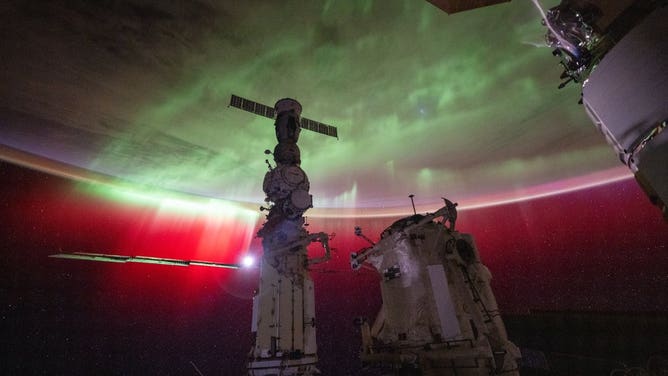See it: NASA astronaut captures mesmerizing view of Northern Lights from space
Earth is experiencing the most intense solar storm since May's extreme geomagnetic storm created auroras even visible in Florida. NASA astronaut Matthew Dominick captured some of the beautiful consequences of space weather in the form of Aurora lights from his view on the International Space Station.
Northern lights dancing in Franklin Grove, Illinois
Video captured by Landon Moeller in Franklin Grove, Illinois shows bright pink, yellow and green aurora lights dancing above the grasslands. The lights were created by a strong geomagnetic storm.
Space weather continues to create vibrant displays of Northern Lights on Earth this week, which are even more astonishing 250 miles above the planet where astronauts work and live.
Over the weekend, the Sun produced at least five powerful solar flares with coronal mass ejection, sending charged particles blasting toward Earth. On Monday, NOAA's Space Weather Prediction Center issued a Geomagnetic Storm Warning as severe storm impacts were underway, a level 4 out of 5 on NOAA's space weather scale. It's the most intense solar storm since May's extreme geomagnetic storm created auroras even visible in Florida.
SEE THE SIGHTS AS AN EXTREME GEOMAGNETIC STORM TRIGGERS JAW-DROPPING AURORAS AROUND THE WORLD
Since arriving at the International Space Station this spring, NASA astronaut Matthew Dominick has embraced his unique vantage point in orbit to capture breathtaking views of space, spacecraft and weather on Earth.

A photo of Aurora lights taken from the International Space Station by NASA astronaut Matthew Dominick.
Dominick and the other astronauts on the ISS experience nighttime every 90 minutes, giving them a good opportunity to photograph the Aurora lights. This weekend was no different, with Northern Lights on display and a new supply run recently arrived just in time with new camera lenses to help capture the celestial show.
Dominick's photo, shared on Sunday night, shows the Moon peaking out along the horizon of Earth, with bright red and green Aurora lights shimmering under the space station.
Dominick posted two versions of the same photo. The first shows how the astronauts view Earth from the ISS cupola. He said he usually rotates his images 180 degrees because it appears "more natural" to those who haven't been living in space. He also posted another version from a perspective looking down at Earth.
THE HISTORY OF EARTH'S GREATEST SOLAR STORMS
"I guess I forgot this time, perhaps because I have grown accustomed to the ‘upside down’ orientation. Here it is 'right side up,'" Dominick wrote on X.

NASA astronaut Matthew Dominick rotated this image 180 degrees to show the Aurora lights as though you are looking down at Earth.
(NASA)
Dominick recently spoke with FOX Weather during a live interview from the International Space Station about some of his experiences, including photographing the eye of Hurricane Beryl.
